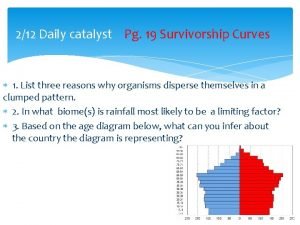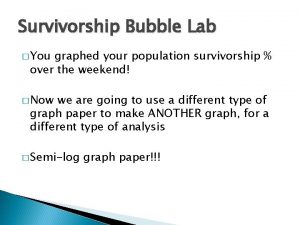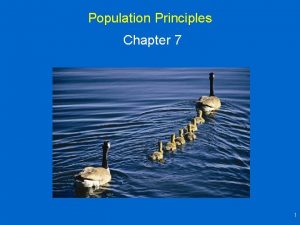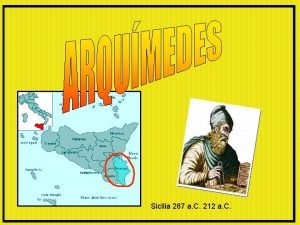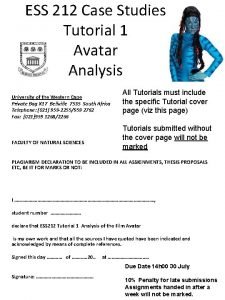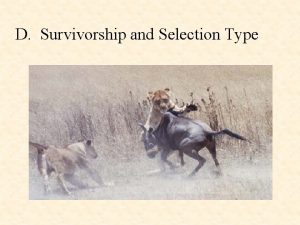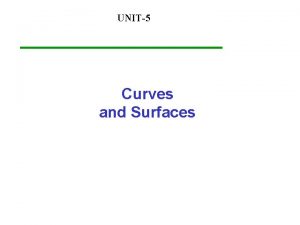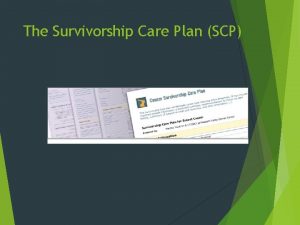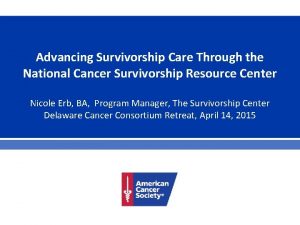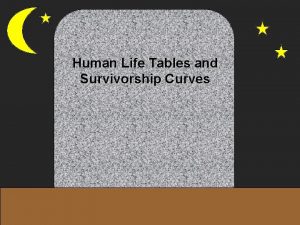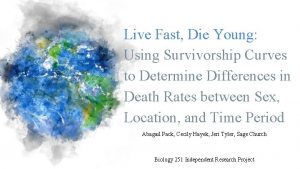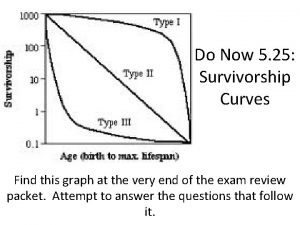212 Daily catalyst Pg 19 Survivorship Curves 1




























- Slides: 28

2/12 Daily catalyst Pg. 19 Survivorship Curves 1. List three reasons why organisms disperse themselves in a clumped pattern. 2. In what biome(s) is rainfall most likely to be a limiting factor? 3. Based on the age diagram below, what can you infer about the country the diagram is representing?

2/12 Class Business Pg. 19 Survivorship Curves Quiz #5 on Friday Ecology Research paper topic Sign up with Mrs. Ireland Library work day on Friday Rubric on Friday Mardi Gras check in (2/20 -Friday) Stacie. ireland@gmail. com Test corrections due Monday after Mardi Gras break I will post the key on Thursday-Friday

2/12 Class Business Just a reminder: NO HOODS No even tucked in. This is your last warning then they are mine No hats in the building. Even if you take it off in the class. No headphones, even hanging out of your shirt! This is your last warning then they are mine! ID’s and tucked in shirts at all times! Clear backs and purses must be small! Tardies- NO MORE! We will move to more of drastic measure

2/12 Class Business Seniors: Scholarship opportunities available! Pell Grants Delgado will be on campus (2/25) Juniors AND Seniors ACT on March 17 th You should be studying! 18+ (cords) EOC rewards for goods and excellent: Ci. Ci’s pizza

2/12 Agenda Daily Catalyst Class Business Daily Objective Survivorship curves Lab Homework: lab conclusion

Age structures also reveal social and economic trends

Dispersion Notebook questions Pg. 18 1. What is the most common type of dispersion? a. List reasons why this pattern is most common. b. Give 3 examples of this pattern in a real ecosystem 2. What is the likely dispersion pattern of fish that swim in schools, seabird nesting on a small field, and thistles growing in a fairly uniform field? 3. What affects the size of populations? Think broadly and what affects the human and non-human population? 4. What would be the likely cause of bushes of one species growing in one area in a uniform spaced pattern? a. random distribution of seeds b. interactions among individuals in the population c. chance d. equal nutrient supplies in that area e. variation in sunlight 5. Define dispersion:

2/12 Objective • Discover how patterns of survivorship relate to the classic three types of survivorship curves.

Survivorship curves Age diagrams show us the relative number of individuals at each age. Survivorship curves can show us characteristics of the population. Key Point #1: Survivorship curves show us survival characteristics of the population.

Describe the characteristics of these populations:

Describe the characteristics of these populations:

Describe the characteristics of these populations:

Compare and contrast these organisms to one another.

Survivorship Curves Type I: • High survival rate in young • Effective parenting • Overall low death rates Type II: • Constant death rate • Limited parenting Type III: • • High death rate in young No parenting A lot of offspring because so many die Once survive till a certain age, high survival rate

Match the curves to the populations Type I Type 2 Type 3

Let connect the dots

Pg. 20 Bubble Lab 1 2 3 4 5 6 7 8 A B A B Eva Kayla Wyatt Daniel V. Stephen Zaven Fabian Alfred Terriyan Eric Barrian Eduardo Brian Travis Andrea Nicoh Stephan ie Chris Daniel G. David Amani Nick Chase Ridel Darrius Francisc o Eliud Evonte Hefer

Survivorship Curve Lab Directions: In a group of four, complete the lab. Read ALL directions carefully before beginning. Your lab information will be on page. 20 Bubble Lab. Person A: Timer Person: Bubbler Person C: Counter Person D: Recorder Time: 25 minutes Noise: 2 (with group)

Survivorship Curve Lab Directions: After you have read the lab, as a group formulate your hypothesis about the following question. Which population will have a higher life expectancy? Population A or B? Every member of the group will need the hypothesis, chart, conclusions and post lab questions completed in their notes. 1, 2, 7, 8, 9

2/12 Exit Ticket #5 Name: _____ period: 2 date: 2/12 Score: _______/4 QP: 1. What would likely be the cause of bushes of one species growing in one area in a uniform spacing pattern? a. random distribution of seeds b. interactions among individuals in the population c. chance d. the equal nutrient supplies in that area 2. What type of survivorship curve would a human being display? 3. What type of growth model do populations show in a stable environment (logistical or exponential)? 4. True or false, Frogs show type I curve because they take good care of their offspring.

9/9 Exit Ticket #4 1. What would likely be the cause of bushes of one species growing in one area in a uniform spacing pattern? a. random distribution of seeds b. interactions among individuals in the population c. chance d. the varied nutrient supplies in that area e. variation in sunlight B, human plants the seeds in that pattern 2. What is the likely dispersion pattern: • fish that swim in schools- Clumped • seabird nesting on a small field- Uniform • thistles growing in a fairly uniform field? - Random 3. What is the most common type of dispersion? Why? Clumped because of protection, hunting, mating, and social behavior

2/13 Pg. 20 Bubble Lab On page 20, create the chart for the bubble lab. You may need more than 8 seconds of death!

2/13 Class Business Ecology Research paper topic Sign up with Mrs. Ireland Library work day on Friday Rubric on Friday Mardi Gras check in (2/20 -Friday) Stacie. ireland@gmail. com Test corrections due Monday after Mardi Gras break I will post the key on Thursday-Friday

Remind 101

2/13 Agenda Daily Catalyst Class Business Timed 10 Quiz #5 Library work time

Timed 10 Directions: Silently and independently complete the timed 10. Hold onto your answer sheet until time is up. Time: 10 minutes Noise: 0 (SILENCE)

Quiz #5 Directions: Silently and independently complete Quiz #5. Turn your quiz into the basket when you are finished and work on your test #2 test corrections. Time: 16 minutes Noise: 0 (SILENCE)

Library Work Time Rules: BE RESPECTFUL AT ALL TIMES! Watch your language, cell phone, and behavior Let’s be productive! Rubric
 Poem catalyst
Poem catalyst Survivorship bias
Survivorship bias Type 1 and 2 survivorship curve
Type 1 and 2 survivorship curve Bubble survivorship lab
Bubble survivorship lab Survivorship vancouver
Survivorship vancouver K selected species survivorship curve
K selected species survivorship curve Bubble lab survivorship
Bubble lab survivorship Population growth curve
Population growth curve Type 1 survivorship examples
Type 1 survivorship examples Population ecology def
Population ecology def Survivorship curve for k selected species
Survivorship curve for k selected species How to calculate survivorship
How to calculate survivorship Garra de arquímedes
Garra de arquímedes Tipos de arcos para aislamiento absoluto
Tipos de arcos para aislamiento absoluto Cls 212
Cls 212 Archimedes last words
Archimedes last words Nkb no 47b
Nkb no 47b Et 212
Et 212 Cls 212
Cls 212 Physics 212 gradebook
Physics 212 gradebook X:3=212
X:3=212 Et 212
Et 212 Cls 212
Cls 212 Cls 212
Cls 212 Cmpe 212
Cmpe 212 Phys 212 equation sheet
Phys 212 equation sheet Nkb 212 sungguh inginkah engkau lakukan
Nkb 212 sungguh inginkah engkau lakukan Frequency response curve of an amplifier
Frequency response curve of an amplifier Avatar 212
Avatar 212



